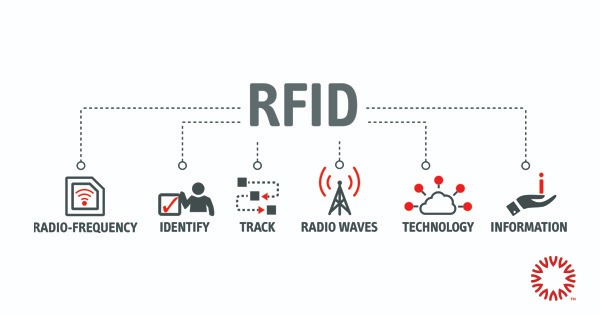RFID Solution
WHAT IS RFID?
RFID is an acronym for “radio-frequency identification” and refers to a technology whereby digital data encoded in RFID tags or smart labels (defined below) are captured by a reader via radio waves. RFID is similar to barcoding in that data from a tag or label are captured by a device that stores the data in a database. RFID, however, has several advantages over systems that use barcode asset tracking software.
The most notable is that RFID tag data can be read outside the line-of-sight, whereas barcodes must be aligned with an optical scanner.
HOW DOES RFID WORK?
RFID belongs to a group of technologies referred to as Automatic Identification and Data Capture (AIDC). AIDC methods automatically identify objects, collect data about them, and enter those data directly into computer systems with little or no human intervention. RFID methods utilize radio waves to accomplish this. At a simple level, RFID systems consist of three components: an RFID tag or smart label, an RFID reader, and an antenna. RFID tags contain an integrated circuit and an antenna, which are used to transmit data to the RFID reader (also called an interrogator). The reader then converts the radio waves to a more usable form of data. Information collected from the tags is then transferred through a communications interface to a host computer system, where the data can be stored in a database and analyzed at a later time.

RFID TAGS AND SMART LABELS
As stated above, an RFID tag consists of an integrated circuit and an antenna. The tag is also composed of a protective material that holds the pieces together and shields them from various environmental conditions. The protective material depends on the application. For example, employee ID badges containing RFID tags are typically made from durable plastic, and the tag is embedded between the layers of plastic. RFID tags come in a variety of shapes and sizes and are either passive or active. Passive tags are the most widely used, as they are smaller and less expensive to implement. Passive tags must be “powered up” by the RFID reader before they can transmit data. Unlike passive tags, active RFID tags have an onboard power supply (e.g., a battery), thereby enabling them to transmit data at all times.
Smart labels differ from RFID tags in that they incorporate both RFID and barcode technologies. They’re made of an adhesive label embedded with an RFID tag inlay, and they may also feature a barcode and/or other printed information. Smart labels can be encoded and printed on-demand using desktop label printers, whereas programming RFID tags are more time consuming and requires more advanced equipment.
RFID APPLICATIONS


